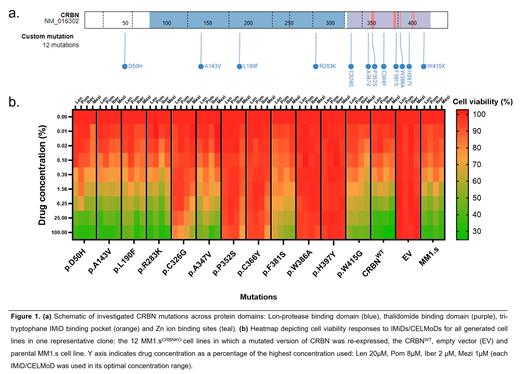Introduction
Immunomodulatory drugs (IMiDs) have revolutionized the treatment of myeloma (MM), with lenalidomide (Len) and pomalidomide (Pom) approved and novel cereblon E3 ligase modulators (CELMoDs, e.g. iberdomide, Iber and mezigdomide, Mezi) in clinical trials. IMiDs and CELMoDs bind to cereblon (CRBN), which is part of the CRL4 CRBN Ubiquitin E3 ligase complex, leading to the ubiquitination and subsequent degradation of neo-substrates including the transcription factors Ikaros and Aiolos which are critical for MM cell survival. Previous data suggests almost one third of myeloma patients acquire CRBN mutations by the time they are Pom refractory. Some events, including stop codons/frameshift mutations and copy loss, have clearly explicable effects on cereblon function. However, many are point mutations with some occurring outside of the thalidomide binding domain and at variable cancer clonal fractions. We sought to understand which mutations were deleterious to cereblon function and whether any mutations were associated with a differential response between IMiDs and CELMoDs.
Methods
From the 36 CRBN mutations previously reported in patient datasets, 12 missense mutations were selected for functional investigation (fig.1a). All mutations were mapped on to the publicly available crystallographic 3D structures of CRBN bound to IMiDs and CELMoDs to aid in predicting the potential functional effect of each mutation.
CRBN knock out (KO) MM1.s cell lines were generated using CRISPR-Cas9 and confirmed to have homozygous loss at the first few exons of the CRBN sequence. Once validated, two independent MM1.s CRBNKO cell line clones were transduced with plasmids expressing either CRBN wild type control (CRBN WT) or mutated CRBN (generated using site directed mutagenesis) leading to stable expression. All cell lines were assessed for response to IMiDs and CELMoDs using cell viability assays (CellTitre Blue, 5 days, Len max. concentration 20uM, Pom 8uM, Iber 2uM and Mezi 1uM) and their ability to degrade neo-substrates assessed using Western blotting for Aiolos and downstream effects using RT-qPCR for IRF4, at 24 hrs.
Results
Knock out of CRBN in MM1.s cells led to complete resistance to IMiDs/CELMoDs. The re-expression of wild type CRBN re-sensitised MM1.s CRBNKO cells to IMiDs/CELMoDs with degradation of Aiolos, downregulation of IRF4 and a similar effect on cell viability to that seen in parental MM1.s. In contrast, the “positive control” mutation p.W386A located within the tri-tryptophan IMiD/CELMoD binding pocket appeared to completely inactivate CRBN with no change in Aiolos/IRF4 expression levels and no effect on cell viability after incubation with all IMiDs/CELMoDs. A second mutation, also in very close proximity to the tri-tryptophan binding pocket and within the neo-substrate binding area (p.H397Y), had the same effect suggesting mutations here entirely prevent all IMiD and CELMoD activity (fig.1b).
In contrast, some CRBN mutations appeared to have no deleterious effect on CRBN function with response to all IMiDs and CELMoDs regained on re-expression at the same magnitude as seen with wild type CRBN re-expression. These mutations included all those located in the Lon protease-like domain (p.D50H, p.A143V, p.L190F, p.R283K) and two within the thalidomide binding domain but not close to the tri-tryptophan binding pocket nor neo-substrate binding area (p.A347V and p.W415G)(fig.1b).
The remainder of the mutations studied appeared to abrogate the activity of the IMiDs lenalidomide and pomalidomide but retained some response (both degradation and viability) to iberdomide (p.C326G), and to a greater extent mezigdomide (p.C326G, p.P352S, p.C366Y and p.F381S), suggesting these compounds were able to partially compensate the effect of the mutation (fig.1b). This may be due to the more potent CELMoD compounds being able to overcome structural changes induced by some mutations but not others.
Discussion
These data highlight key differences in the functional impact of different CRBN missense mutations that have been previously identified in patients. These results may have important implications for the interpretation of CRBN sequencing results from patients for future therapy decisions, particularly differentiating those who may, despite relapsing on IMiDs with CRBN mutations, have the potential to still benefit from the use of CELMoD agents.
Disclosures
Walker:Abbvie: Speakers Bureau; Bristol Myers Squibb: Research Funding; Genentech: Research Funding. Pawlyn:Takeda: Honoraria; Pfizer: Honoraria, Membership on an entity's Board of Directors or advisory committees; Sanofi: Honoraria, Membership on an entity's Board of Directors or advisory committees; GSK: Honoraria; Janssen: Honoraria, Membership on an entity's Board of Directors or advisory committees; BMS/Celgene: Honoraria, Membership on an entity's Board of Directors or advisory committees; Amgen: Honoraria; Abbvie: Consultancy, Honoraria.


